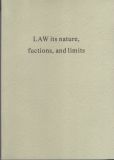用户登陆搜 索 |
查看图书
图书目录: Part One: The nature of law
The elements of a system of law Section One: Introduction. Section Two: Conceptions and Miscon- ceptions of Law--A Discussion by Two Legal Scholars. Section Three: The Elements of a Modern Legal System. Section Four: Terminology .and Basic Distinctions. 2. Is law necessary? Section One: Introduction. Section Two: Is Law Necessary?-The Views of Thomas Hobbes. Section Three: Is Law Necessary?--The Views of Some Communist Theorists. Section Four: Is Law Necessary?-A Dia- logue Between Two Legal Philosophers. 3. Law as a means of social control Section One: Introduction. Section Two: "Means of Social Control"-- A Dialogue Between a Lawyer and a Sociologist. Section Three: Law as a Means of Social Control--The Dialogue Continues. Section Four: The Law and Other Means of Social Control. Section Five: The Effec- tiveness of Law as a Means of Social Control. 4. "Procedure is the heart of the law" Section One: Introduction. Section Two: Substance Distinguished from Procedure; Kinds and Uses of Procedures. Section Three: The Use of Civil Judicial Procedure to Settle Disputes; Dispute Settlement as a Basic Function of Law. Section Four: The Use of Civil Judicial Procedure in Settling a Disputed Claim: White vs. Island Amusement Co. Section Five: The "Pleading" Stage. Section Six: The Pre-trial Stage. Section Seven: The Trial. Section Eight: Post Trial Procedures: "Satisfaction" of Judgment; Appeals. Section Nine: Judicial Reason- ing. Section Ten: Is Procedure the Heart of the Law? Part Two: Some functions of private law 5. Recognition of ownership Section One: Is Legal Recognition of Ownership Necessary? Section Two: The Concept of Ownership. Section Three: Determination oi Ownership. Section Four: Protection of Ownership. Section Five: Limitations on Private Ownership. 6. Provision for redress of harm Section One: Harm and the Law. Section Two: Compensating foi Harm Caused by a Collision--Judicial Solutions. Section Three: Com- pensating for Harm Caused by a Collision-- Legislative Solution. Section Four: Judicial Reaction to the Legislative Solution. 7. Provision for redress of broken agreements Section One: Agreements and the Law. Section Two: Determining Whether a Legally Binding Agreement Has Been Formed. Section Three: Determining What the Agreement Means. Section Four: The General Nature and Extent of Legal Redress for Broken Agreements. 8. Reinforcement of the family Section One: The Family and Its Functions. Section Two: The Use of Law to Reinforce the Family. Section Three: Monogamous Mar- riage and Family Solidarity. Section Four: Protection of the Family from Third Party Interferences. Section Five: Divorce Law and Pres- ervation of the Family. Part Three: Some functions of public law 9. Preservation of the existing legal system Section One: Threats to the Legal System. Section Two: The Law of Treason. Section Three: Laws Controlling "Militant" Political Parties. lO. Maintenance of"law and order" Section One: The Use of Law to Maintain Order. Section Two: The Use of the Criminal Law to Maintain Order. Section Three: Is All Socially Disruptive Conduct Deterrable by the Processes of the Criminal Law? Section Four: Deterrence of Socially Disruptive Con- duct and the Rehabilitation of Convicted Offenders. Section Five: Is the Death Penalty Necessary to Deter Some Types of Socially- Disruptive Conduct? 11. Protection of basic freedoms Section One: Basic Freedoms. Section Two: Constitutional Protection of Basic Freedoms. Section Three: Implementation of Constitutional Protection of Basic Freedoms. Section Four: Are Constitutionally Pro- tected Freedoms Absolute and Unqualified? 12. Surveillance of official action o Section O'ne: The Surveillace Problem. Section Two: Surveillance of Legislative Action. Section Three: Surveillance of Executive and Administrative Action. Section Four: Surveillance of Police and Prosecutor. Section Five: Surveillance of the Judiciary. Section Six: The Independence of the Judiciary. Part Four: Law and social change 13. The legislature and social change Section One: Social Change and the Law. Section Two: The Industrial Revolution and the Rise of Monopolies. Section Three: Monopolies and the Common Law. Section Four: Congress Confronts the Monop- olies: The Sherman Act. 14. The courts, administrators, and social change Section One: Social Change and the Collaboration of Legal Institu- tions. Section Two: The Courts and the Sherman Act's "Rule of Reason." Section Three: Administrators and the Sherman Act. Section Four: Private Citizens and the Sherman Act. Part Five: The limits of effective legal action 15. Disputes the law cannot effectively settle Section One: Effective Dispute Settlement. Section Two: Settlement of Disputes Within the Family. Section Three: Settlement of Disputes Within Religious Bodies. Section Four: Settlement of Labor-Manage- ment Disputes. 16. Conduct the law cannot effectively coerce Section One: Roscoe Pound on the Limits of Effective Legal Action. Section Two: The Use of Law to Enforce or to "Repeal" Morality. Section Three: The Use of Law to Establish or to "Disestablish" Reli- gion. Section Four: The Use of Law to Perpetuate or to Eliminate Racial Discrimination. Section Five: The Limits of Effective Legal Action and the Duty to Obey the Law. |

